No, because I needed to choose one.
Ok! I will go for 0,91R😀
And what do you think about:
Mills Resistor
Series Non-Inductive wirewound power resistors , very popular for xovers, psu and cathode resistors on valve amps
Thanks!
Last edited:
If you mean MUR3020G, yes. All the G suffix means is it is RoHS compliant. Electrical performance is identical.
I wouldn't use the RURG3020 as its a 'soft recovery diode' whilst the MUR3020 is a 'fast recovery diode'
I wouldn't use the RURG3020 as its a 'soft recovery diode' whilst the MUR3020 is a 'fast recovery diode'
RURG3020 Features
• Ultrafast Recovery trr = 50 ns (@ IF = 30 A)
• Max Forward Voltage, VF = 1.0 V (@ TC = 25°C)
• Reverse Voltage, VRRM = 200 V
It is also a Ultrafast Recovery diode but less fast that
MUR3020 Features
t rr = 35ns
IF(AV) = 30Amp
VR = 200V
So...what might happen at Sonic?
Thanks Alex and all.
Here's a teaser of the F5T build guide. I need to take a few more photos and add a few sections...
~~~~~~~~~~~~
F5Turbo v2 (with Cascode) Using the diyAudio F5T ver. 3 PCB
PCB available here - F-5T (6 PCBs, Makes 2 channels; Rev3.0)
Schematic
Please Read — The PCB numbering has been rationalized to match the part numbers and placement on this schematic (The F5Tv3 from Nelson’s article)
You can build any version of the amp from this article, or have multiple outputs, use the Cascode or not, etc… But when referencing the silkscreen to the schematic, remember to use this one.
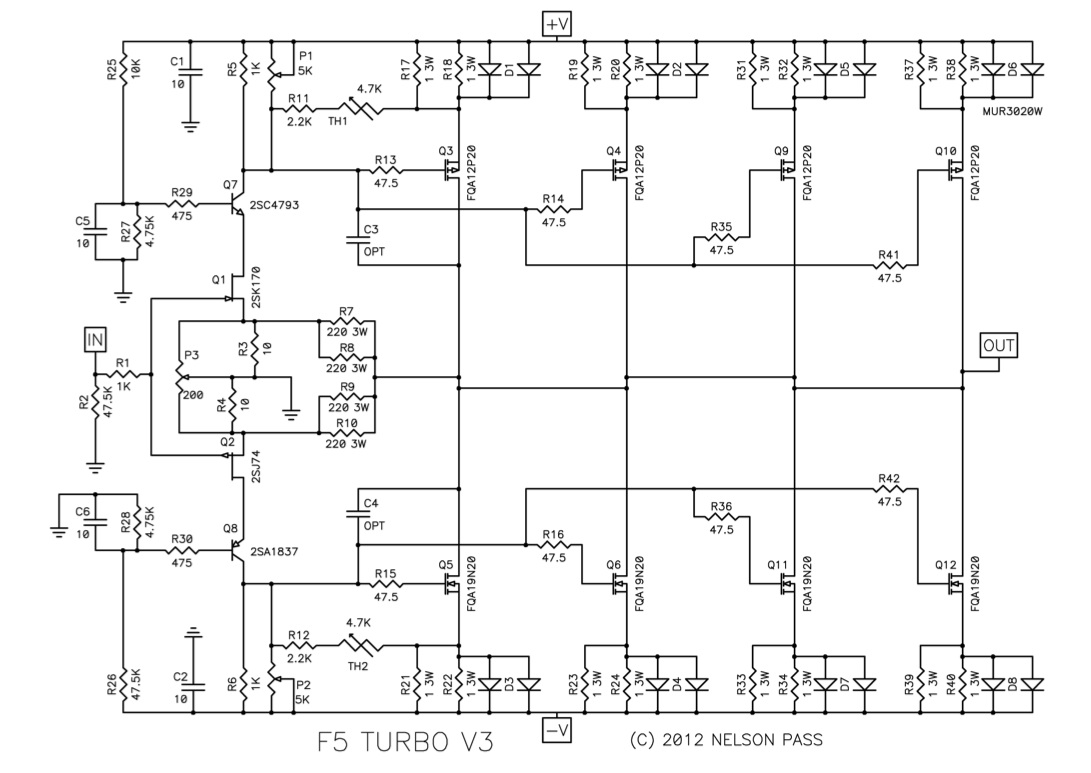
Please have this printed out in front of you when you are stuffing the PCB.
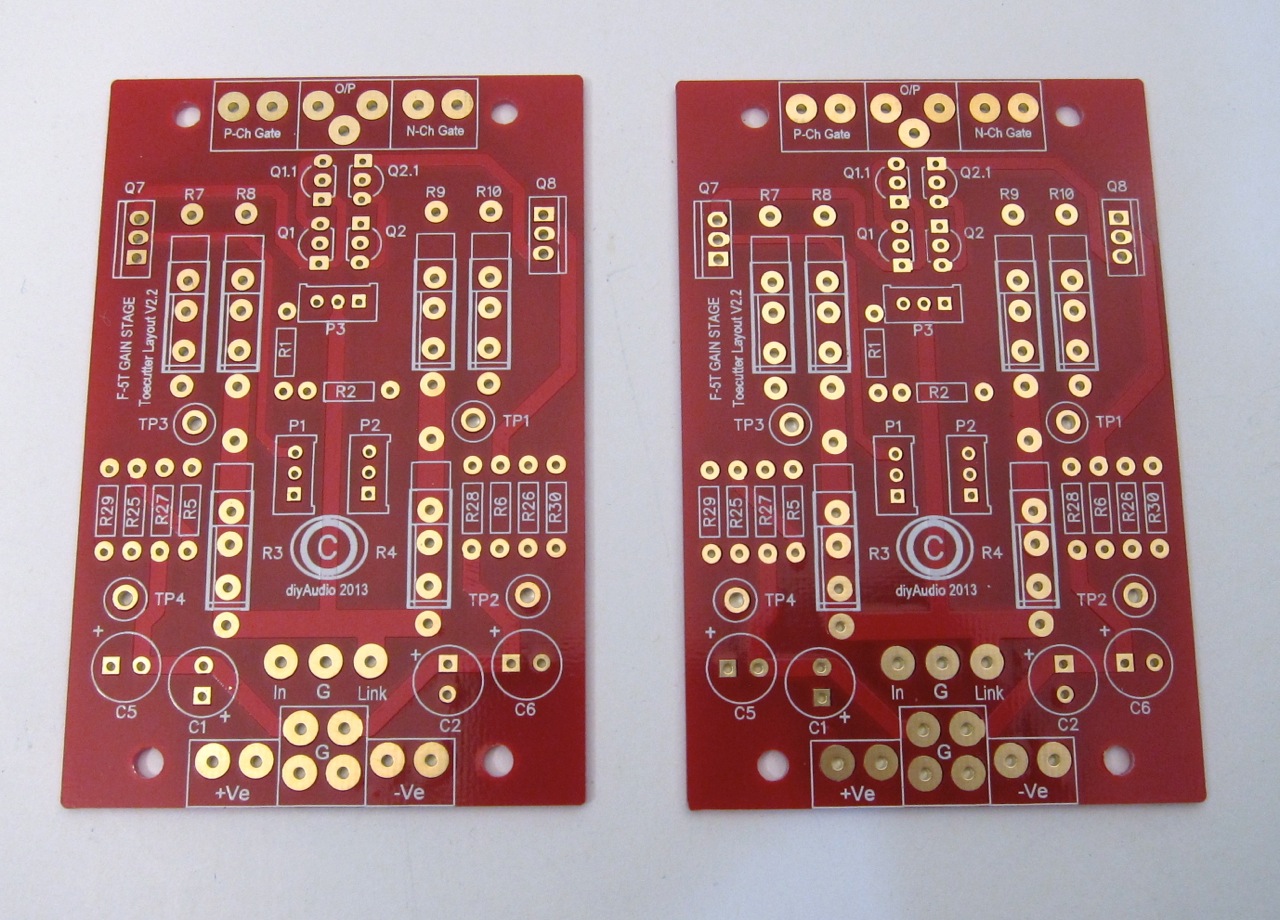
A look at the new PCB.
The biggest changes are the increase in size of the PCB, in order to accommodate holes that will mount to the Universal Mounting Spec. Also there are multiple solder pads at each wire connection point, making it much easier to configure this to any of the F5T variants.
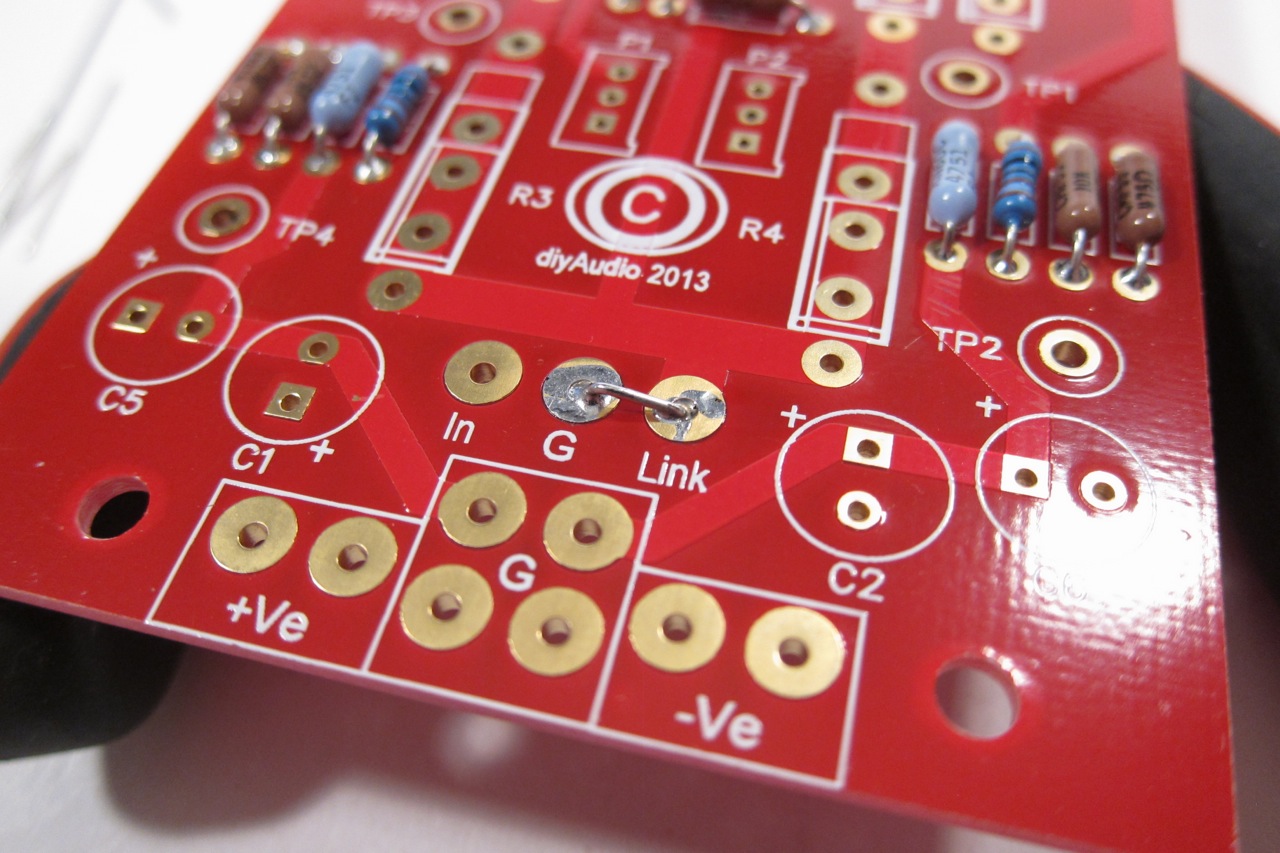
If using single-ended (RCA) inputs remember to add this link at the labeled spot.
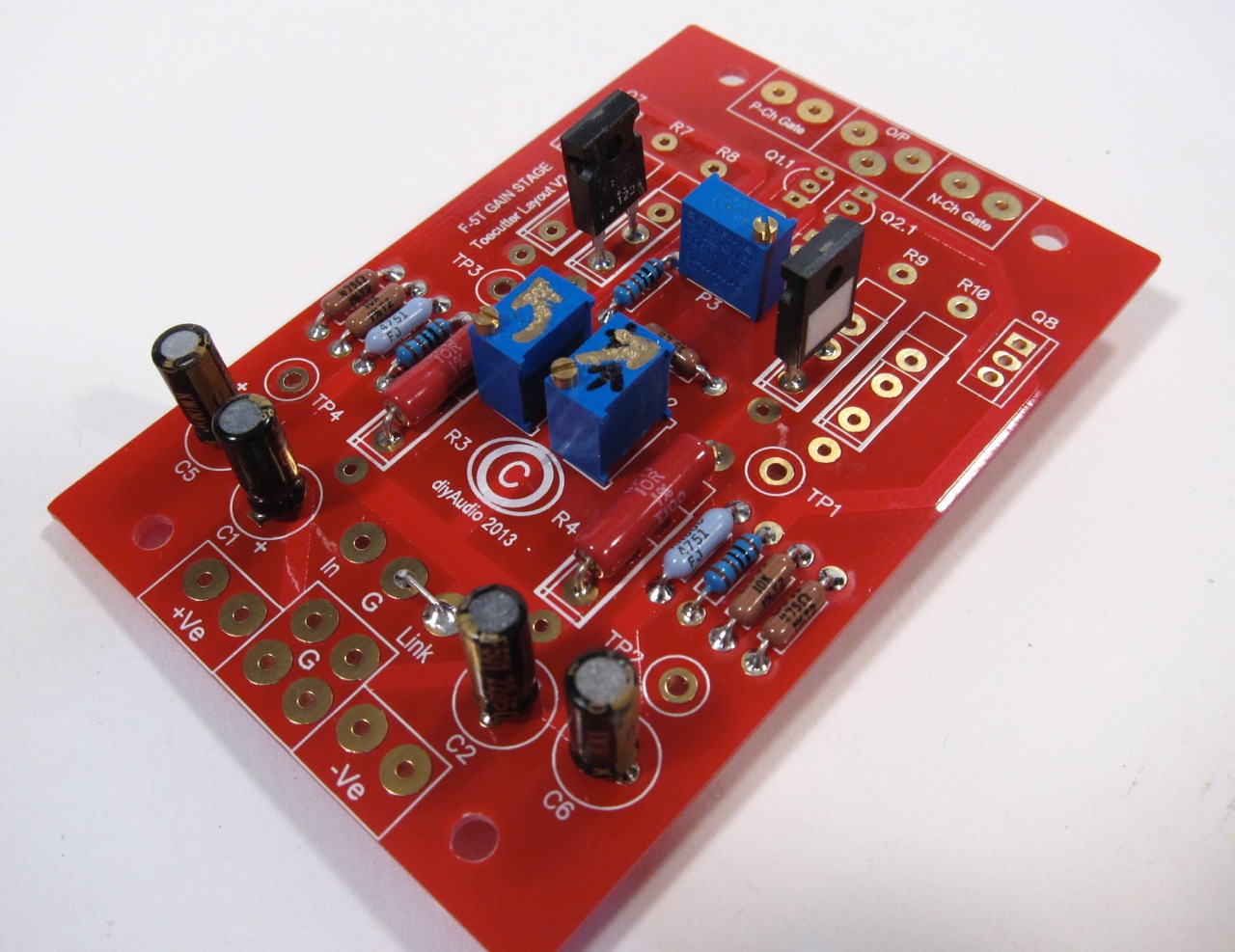
Please remember that this build is showing the cascode circuit being used. It is not strictly necessary for 32V rails, but is required if you choose to use higher voltages. If building a v2, I would suggest not cascoding, simpler is better.
In this build the packages in R8 and R9 are not transistors but high wattage Caddock resistors, I used them as I had them on hand. Most builds will use 3W axial lead resistors in the R7-10 positions.
Also note that because the cascode circuit is used, there are capacitors in the C5, C6 positions. As well as all the associated resistors, and of course the transistors.
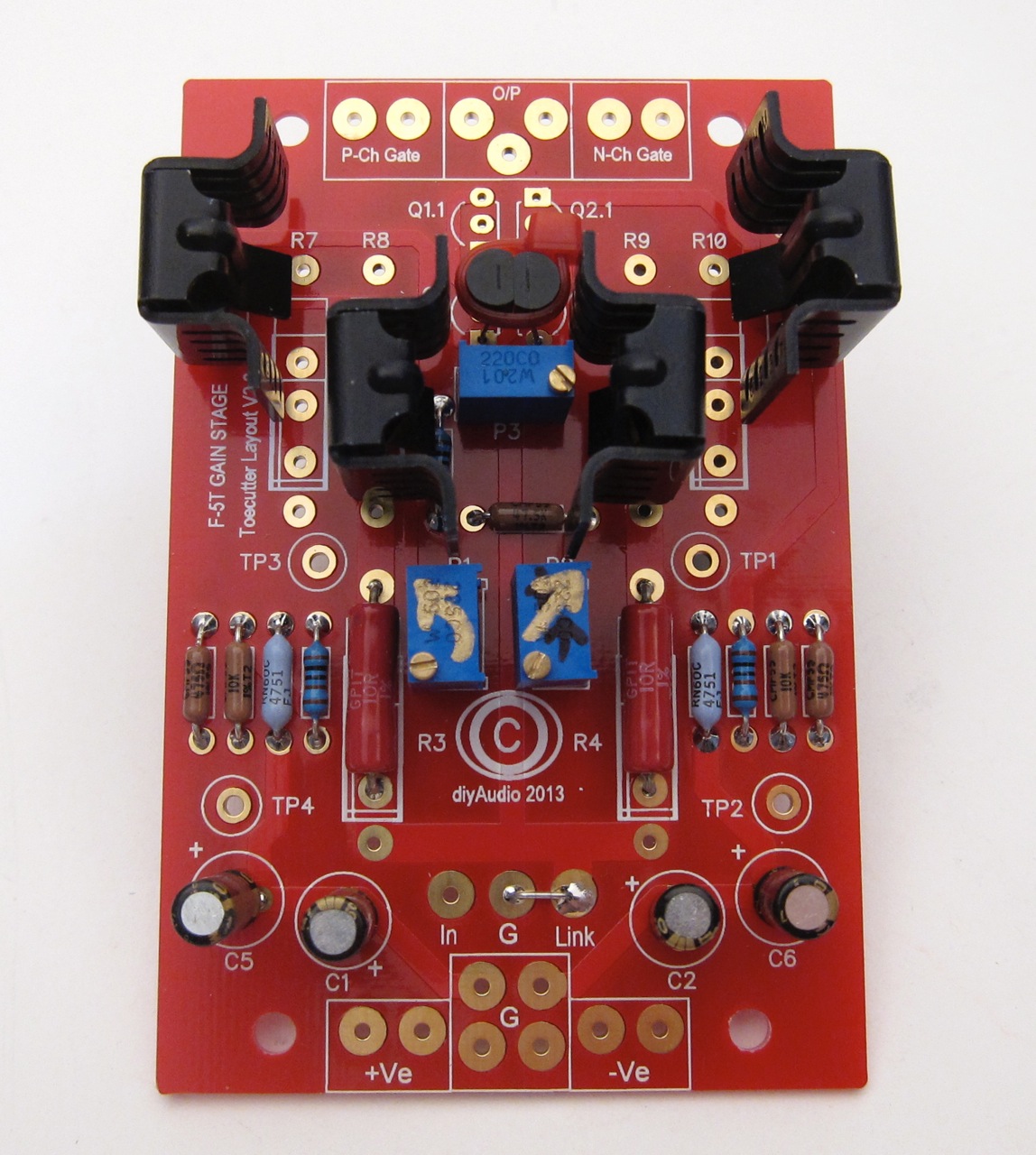
This photo shows the Front-End board (hereafter referred to as “FE board” or “FE”) stuffed in the manner to build a v3 or v2 with cascode. The feedback resistors and cascode transistors have clip-on heatsinks, and the rest of the board is stuffed. The Q1.1 and Q2.1 position are left empty, they are there if you are going to make a huge F5T with more than 4 pair of output transistors, so you can parallel the Jfets and have more driver current.
Note regarding P3 - set to it’s center value before stuffing. Equal resistance from leg 1 to 2, and from leg 2 to 3.

This is stuffed in the typical configuration for a F5Tv2, with the normal style resistors and all the cascode circuitry and transistors empty. (This photos shows the earlier version of the PCB.)
Regardless of the PCB version, if you don’t cascode you need to jumper collector to emitter pads on Q5 and Q6, shown below —
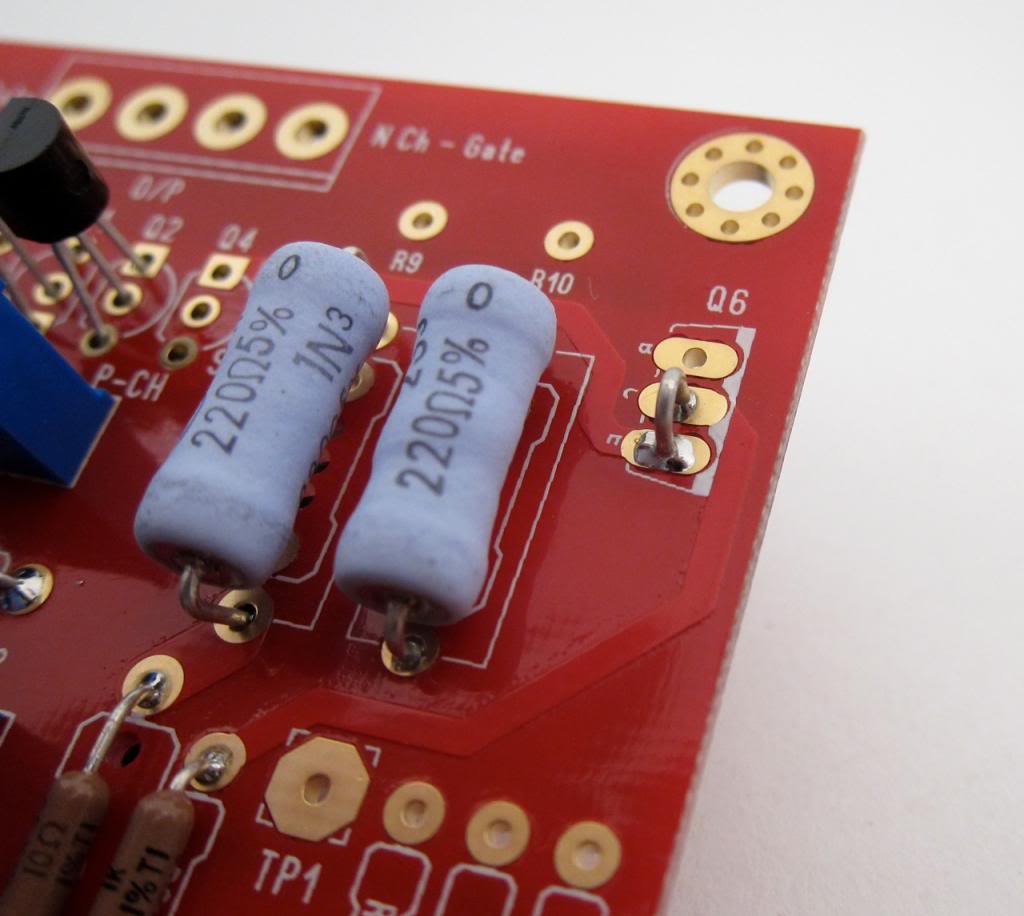
Connect C to E for non-cascode. Watch the labeling, they are mirror image left to right.
(This photo shows the old version PCB, for this illustration there is no practical difference between the old and new.)

(image shows the old version PCB, new version differs only in silkscreen labeling.)
The output boards are very straightforward, the thing to remember is to have the N channel on the right, which will make the hookups rational as well as placing the thermistor on the outside. Also take a few clipped-off resistor leads and make some terminals for the test points (TP1, 2) if you have a voltmeter with clippy probes.

Output boards mount as shown. Some people will suggest that the Mosfets should be lower than the diodes for most efficient heatsink usage. There may be a difference, I can’t tell much, I’ve tried it both ways. The photos with the v3 boards have the fets low.
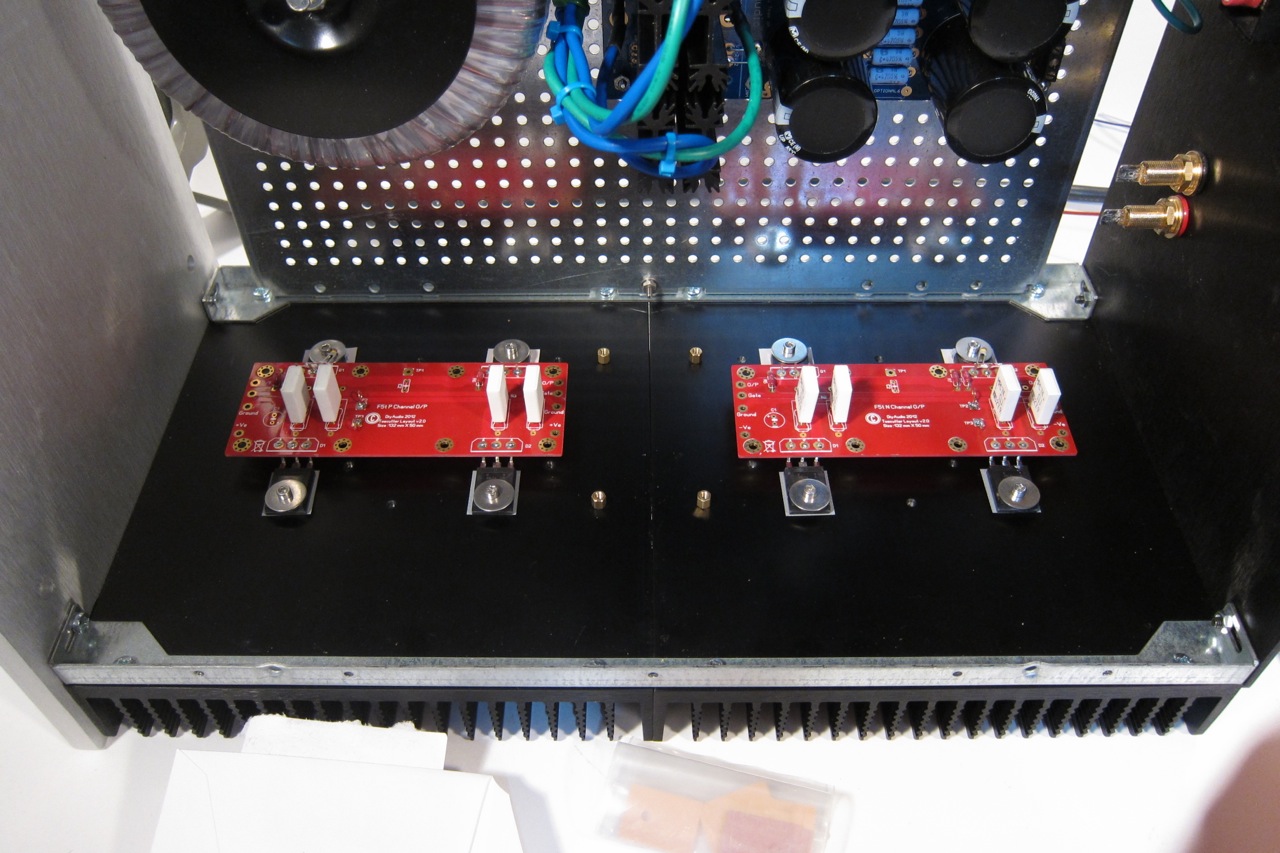
The output boards are shown here with slightly different resistors.Also note the standoffs in the center for mounting the front end PCB.
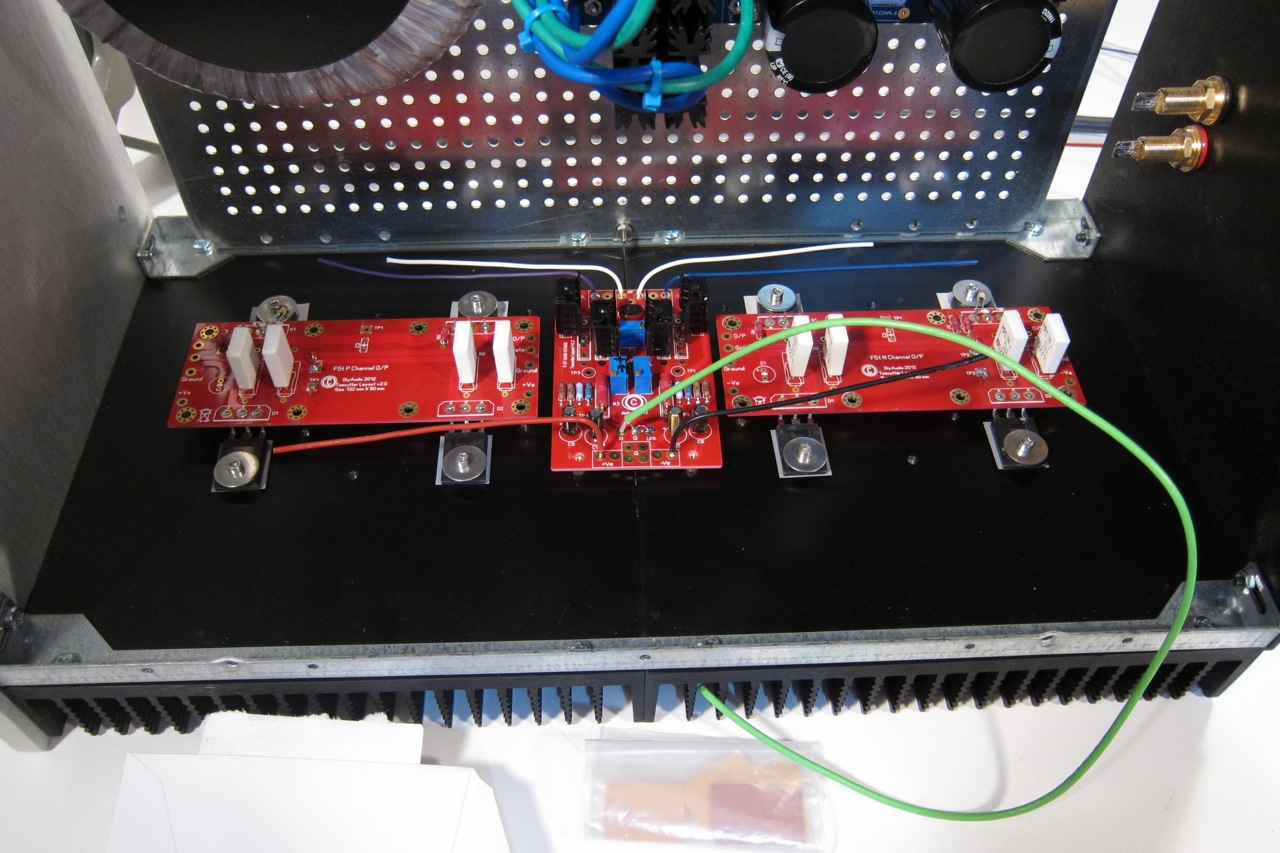
The FE mounts in the center, and it’s easier if you attach some of the wires before installation.
In these photos the color coding is:
V+ = Red
V- = Black
P-Gate = Purple
Output = White
N-Gate - Blue
GND = Green (not shown in this photo)
The brighter green is the input signal, it’s coax and It will also show up in photos as bright red, depending on which channel I happened to photograph…
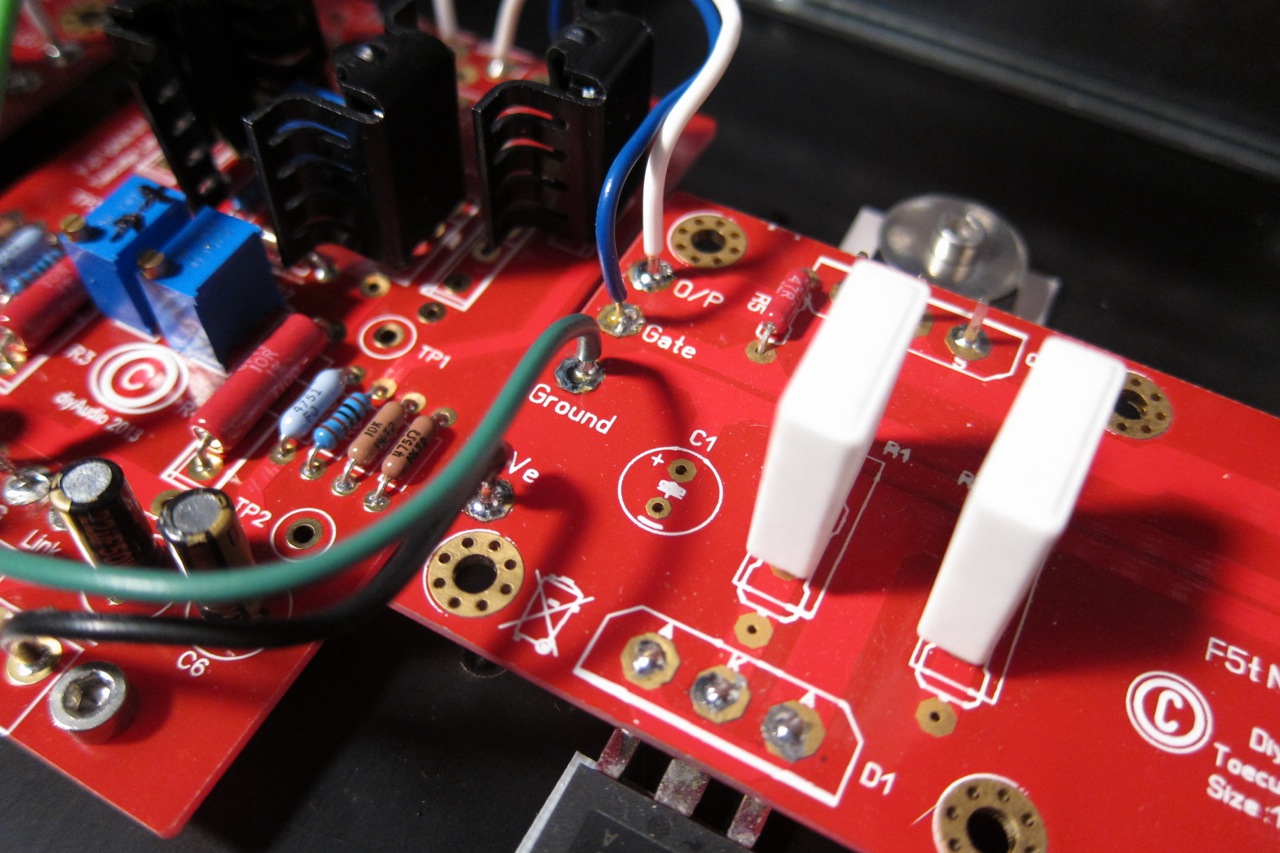
Connections to the output boards.
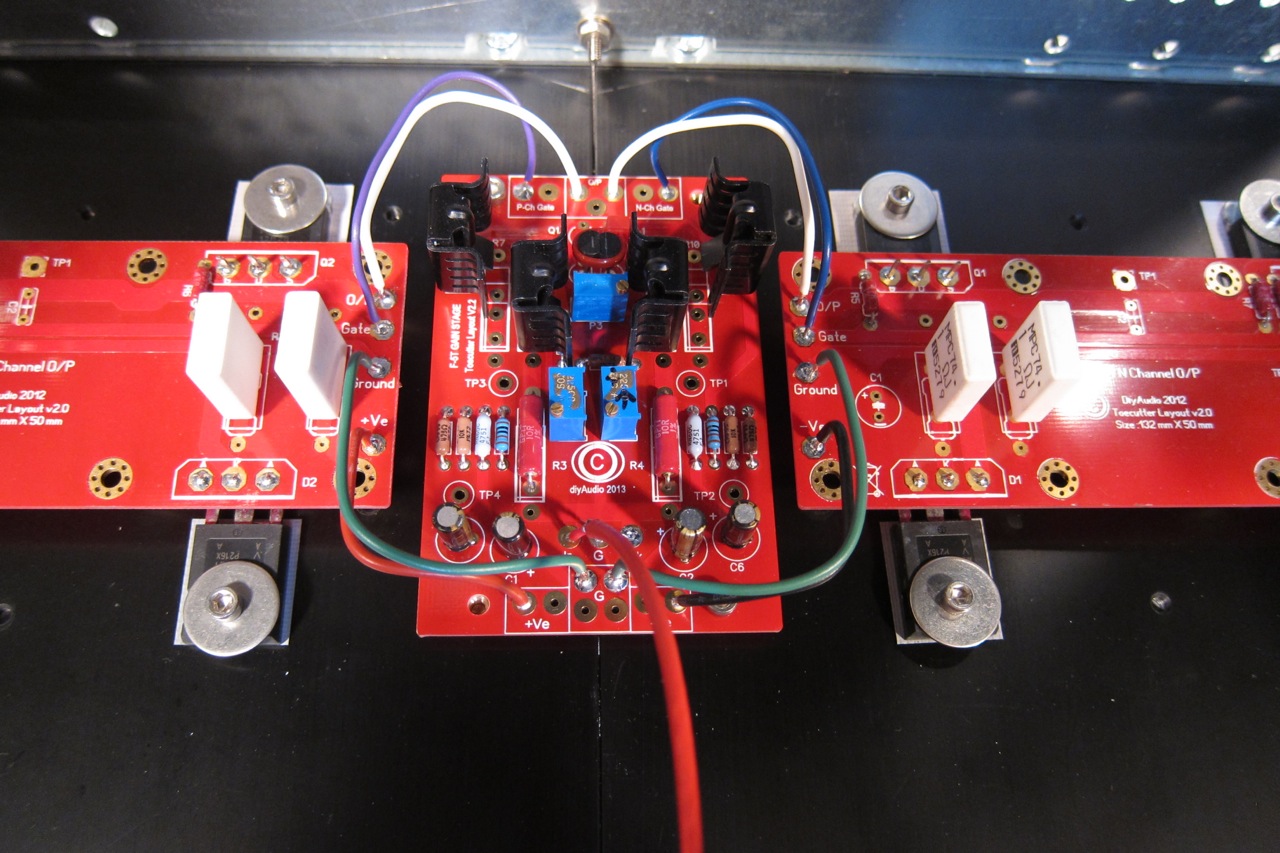
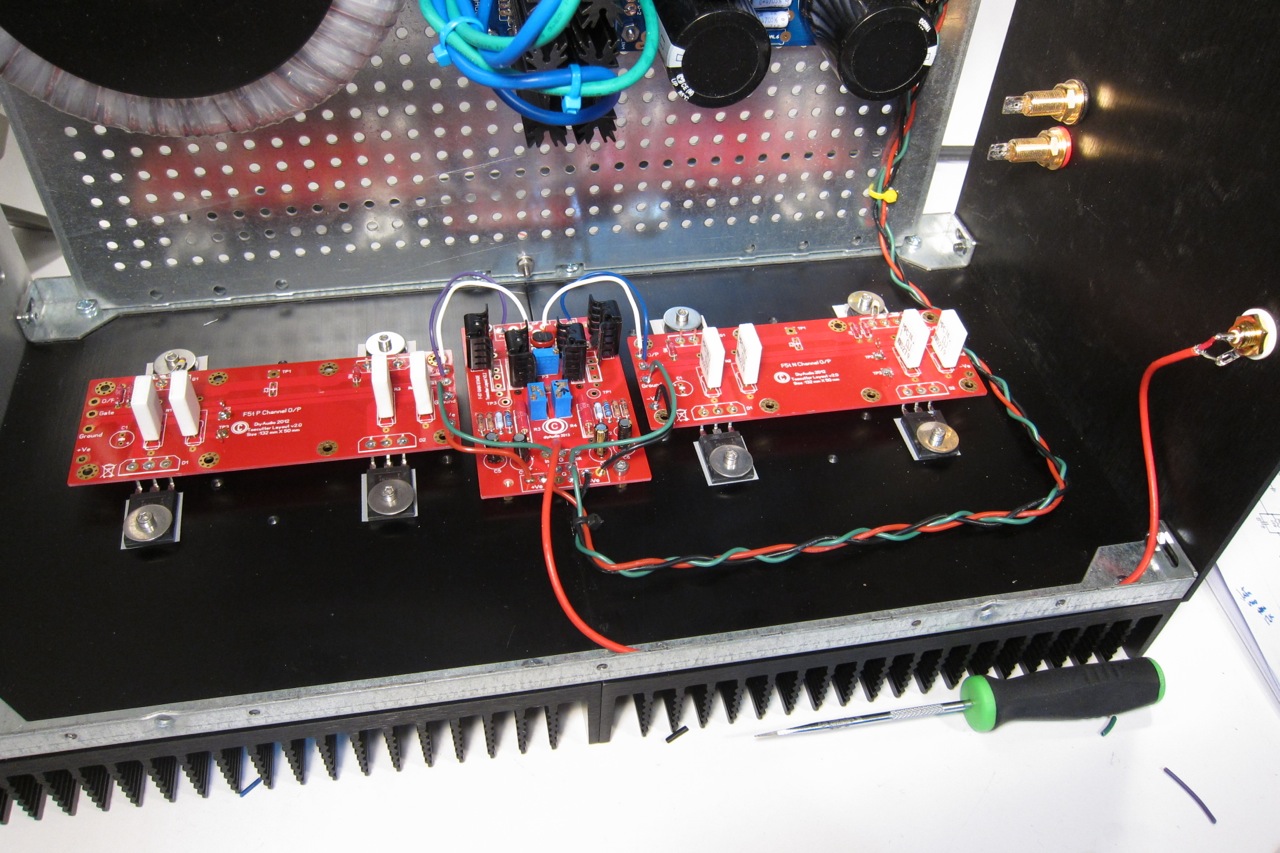
The power from the PSU is connected to the FE board. It is routed as shown for the purpose of clarity and illustration. I strongly suggest you make these connections as short as comfortable.
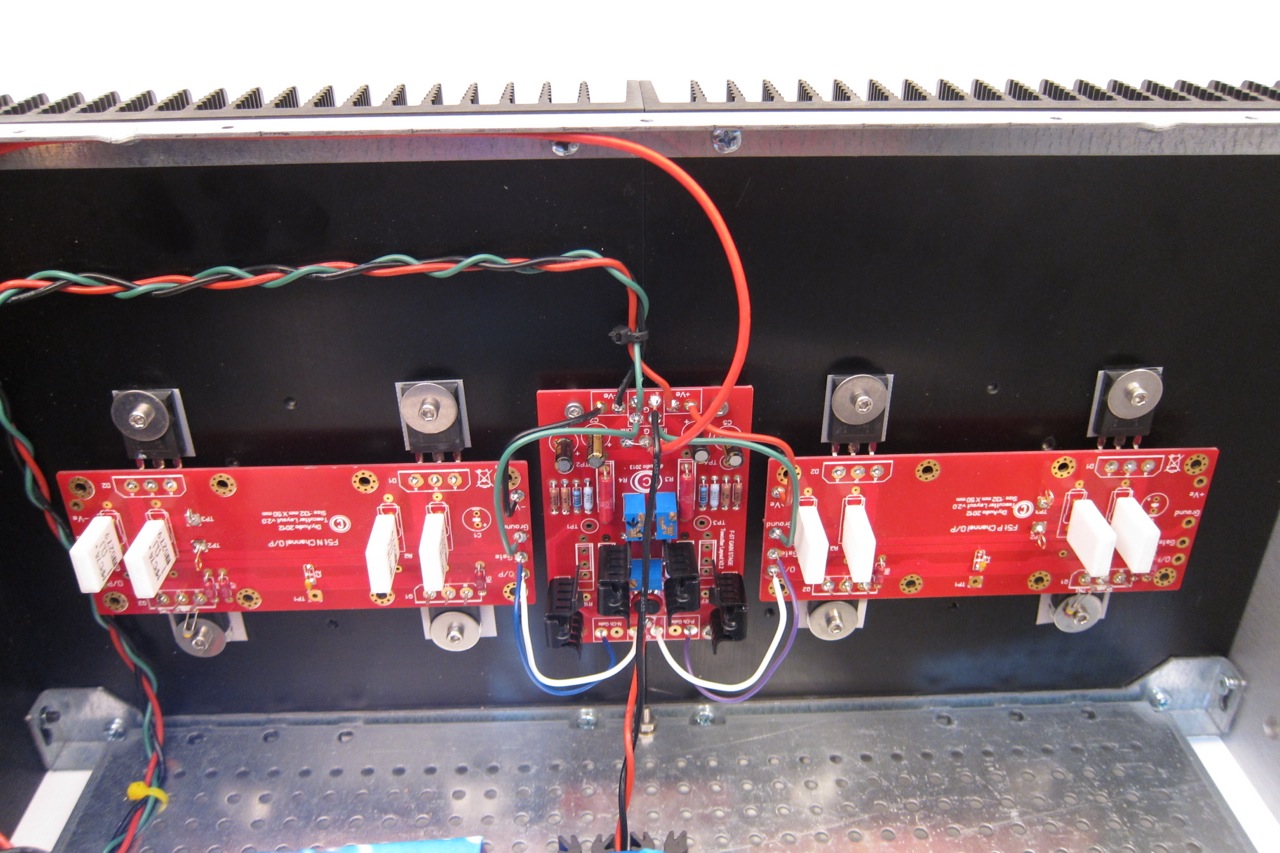
This shows the final connections, the speaker outputs, black and red down the center of the photo.
Power Supply
A stereo F-5T v2 requires a bipolar power supply of (+/- 32V). This will require an 24V+24V (or 48V Center Tapped) transformer from 600-800VA, and PSU capacitance of 80,000uF per rail or more. The F-5T v3 will require two of the above PSU. (One for each monoblock.) If you have the heatsink and proper voltage capacitors you may use even more voltage for more power, see the original article for more information.
Although not the exact PSU as shown in the Nelson Pass article, the diyAudio PSUv3 circuit board can be used to make a suitable power supply for the F5Turbo.
Using the PSUv3 board allows an easy addition of dual diode bridges, which will help keep the transformer mechanical noise to a minimum, and other benefits such as LEDs on each rail, room for (8) capacitors of up to 35mm diameter, the ability to use many different styles of connectors on the board itself, and not to mention the convenience of having everything on one PCB.
The diyAudio universal PSU v3 was made with the requirements of this very amp when it was designed.
An illustrated guide to building the diyAudio PSUv3 can be found here - http://www.diyaudio.com/forums/powe...circuit-board-v3-illustrated-build-guide.html

This is an Antek 600VA 24V+24V transformer. AN-6224

Showing the wiring of the AC to the transformer. This is for 120V

With the PSU board stuffed and installed.
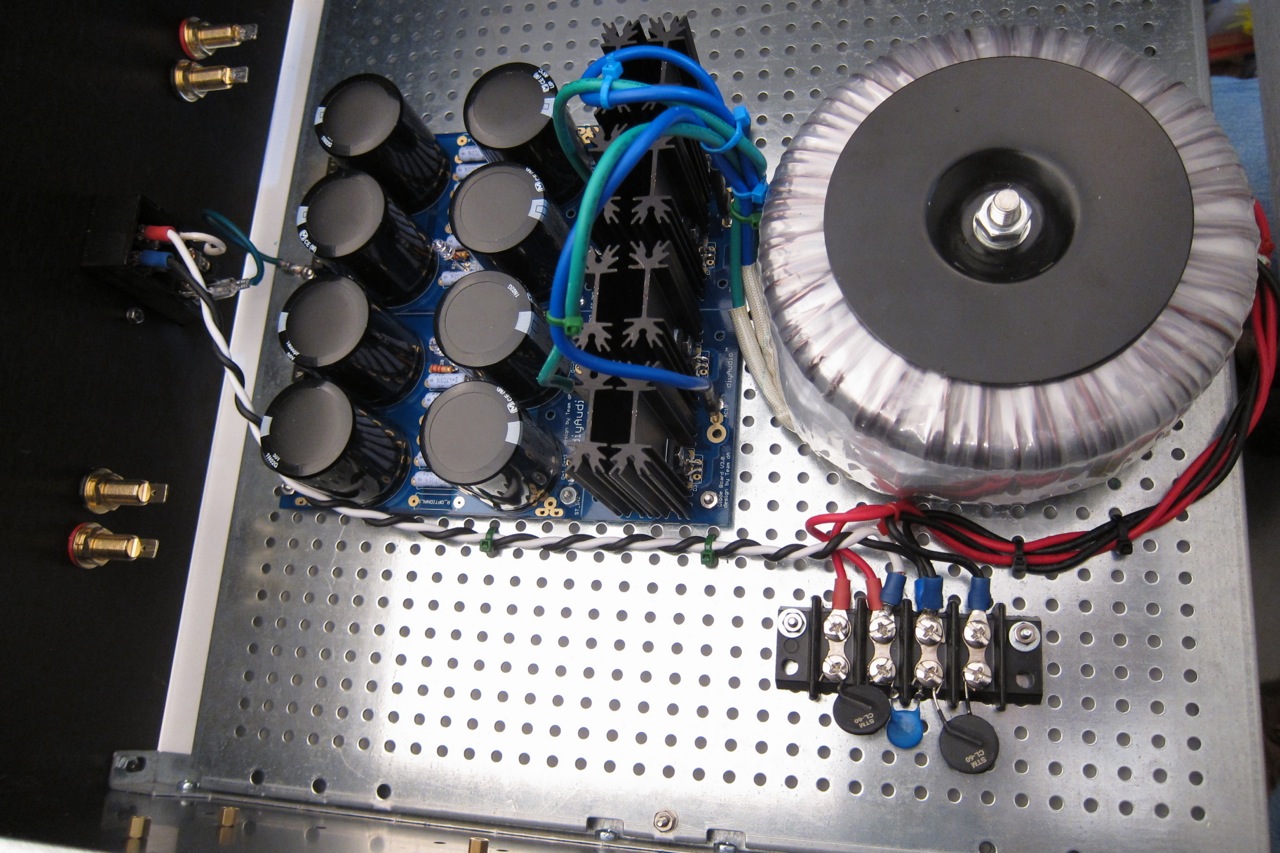
Chassis
This is a high-wattage Class-A amplifier. It has lots of excess heat that needs to be dealt with. The 5U Chassis is of suitable size and dissipation for a Stereo v2 or a monoblock v3.
The 5U and 4U Deluxe chassis from the DIY audio store are basically identical except for size and that the 5U heatsinks are 2 pieces per side.
An illustrated guide to building the Deluxe Chassis (4U) can be found here - http://www.diyaudio.com/forums/parts/245959-illustrated-guide-4u-deluxe-chassis.html
Testing and Powerup
Adjustments (Bias and Offset)
~~~~~~~~~~~~
F5Turbo v2 (with Cascode) Using the diyAudio F5T ver. 3 PCB
PCB available here - F-5T (6 PCBs, Makes 2 channels; Rev3.0)
Schematic
Please Read — The PCB numbering has been rationalized to match the part numbers and placement on this schematic (The F5Tv3 from Nelson’s article)
You can build any version of the amp from this article, or have multiple outputs, use the Cascode or not, etc… But when referencing the silkscreen to the schematic, remember to use this one.

Please have this printed out in front of you when you are stuffing the PCB.

A look at the new PCB.
The biggest changes are the increase in size of the PCB, in order to accommodate holes that will mount to the Universal Mounting Spec. Also there are multiple solder pads at each wire connection point, making it much easier to configure this to any of the F5T variants.

If using single-ended (RCA) inputs remember to add this link at the labeled spot.

Please remember that this build is showing the cascode circuit being used. It is not strictly necessary for 32V rails, but is required if you choose to use higher voltages. If building a v2, I would suggest not cascoding, simpler is better.
In this build the packages in R8 and R9 are not transistors but high wattage Caddock resistors, I used them as I had them on hand. Most builds will use 3W axial lead resistors in the R7-10 positions.
Also note that because the cascode circuit is used, there are capacitors in the C5, C6 positions. As well as all the associated resistors, and of course the transistors.

This photo shows the Front-End board (hereafter referred to as “FE board” or “FE”) stuffed in the manner to build a v3 or v2 with cascode. The feedback resistors and cascode transistors have clip-on heatsinks, and the rest of the board is stuffed. The Q1.1 and Q2.1 position are left empty, they are there if you are going to make a huge F5T with more than 4 pair of output transistors, so you can parallel the Jfets and have more driver current.
Note regarding P3 - set to it’s center value before stuffing. Equal resistance from leg 1 to 2, and from leg 2 to 3.

This is stuffed in the typical configuration for a F5Tv2, with the normal style resistors and all the cascode circuitry and transistors empty. (This photos shows the earlier version of the PCB.)
Regardless of the PCB version, if you don’t cascode you need to jumper collector to emitter pads on Q5 and Q6, shown below —

Connect C to E for non-cascode. Watch the labeling, they are mirror image left to right.
(This photo shows the old version PCB, for this illustration there is no practical difference between the old and new.)

(image shows the old version PCB, new version differs only in silkscreen labeling.)
The output boards are very straightforward, the thing to remember is to have the N channel on the right, which will make the hookups rational as well as placing the thermistor on the outside. Also take a few clipped-off resistor leads and make some terminals for the test points (TP1, 2) if you have a voltmeter with clippy probes.

Output boards mount as shown. Some people will suggest that the Mosfets should be lower than the diodes for most efficient heatsink usage. There may be a difference, I can’t tell much, I’ve tried it both ways. The photos with the v3 boards have the fets low.

The output boards are shown here with slightly different resistors.Also note the standoffs in the center for mounting the front end PCB.

The FE mounts in the center, and it’s easier if you attach some of the wires before installation.
In these photos the color coding is:
V+ = Red
V- = Black
P-Gate = Purple
Output = White
N-Gate - Blue
GND = Green (not shown in this photo)
The brighter green is the input signal, it’s coax and It will also show up in photos as bright red, depending on which channel I happened to photograph…

Connections to the output boards.


The power from the PSU is connected to the FE board. It is routed as shown for the purpose of clarity and illustration. I strongly suggest you make these connections as short as comfortable.

This shows the final connections, the speaker outputs, black and red down the center of the photo.
Power Supply
A stereo F-5T v2 requires a bipolar power supply of (+/- 32V). This will require an 24V+24V (or 48V Center Tapped) transformer from 600-800VA, and PSU capacitance of 80,000uF per rail or more. The F-5T v3 will require two of the above PSU. (One for each monoblock.) If you have the heatsink and proper voltage capacitors you may use even more voltage for more power, see the original article for more information.
Although not the exact PSU as shown in the Nelson Pass article, the diyAudio PSUv3 circuit board can be used to make a suitable power supply for the F5Turbo.
Using the PSUv3 board allows an easy addition of dual diode bridges, which will help keep the transformer mechanical noise to a minimum, and other benefits such as LEDs on each rail, room for (8) capacitors of up to 35mm diameter, the ability to use many different styles of connectors on the board itself, and not to mention the convenience of having everything on one PCB.
The diyAudio universal PSU v3 was made with the requirements of this very amp when it was designed.
An illustrated guide to building the diyAudio PSUv3 can be found here - http://www.diyaudio.com/forums/powe...circuit-board-v3-illustrated-build-guide.html

This is an Antek 600VA 24V+24V transformer. AN-6224

Showing the wiring of the AC to the transformer. This is for 120V

With the PSU board stuffed and installed.

Chassis
This is a high-wattage Class-A amplifier. It has lots of excess heat that needs to be dealt with. The 5U Chassis is of suitable size and dissipation for a Stereo v2 or a monoblock v3.
The 5U and 4U Deluxe chassis from the DIY audio store are basically identical except for size and that the 5U heatsinks are 2 pieces per side.
An illustrated guide to building the Deluxe Chassis (4U) can be found here - http://www.diyaudio.com/forums/parts/245959-illustrated-guide-4u-deluxe-chassis.html
Testing and Powerup
Adjustments (Bias and Offset)
Heat depends on bias and rail voltage. At 32V rails and the article's two likely bias points you'll see around 102 W if you're a fearless amp builder (0.8A per device) or 78W if not (0.6A per device).
That could work in the 4U case, but unless you're driving low impedance speakers you're likely to want to take advantage of the higher rail capability and have proportionally higher dissipation.
That could work in the 4U case, but unless you're driving low impedance speakers you're likely to want to take advantage of the higher rail capability and have proportionally higher dissipation.
You do such nice work.
Thank you. You are the Boswell to my Johnson.
😎
The biggest compliment, you can get Jim 😀
Steve, I'll be happy to when I get my bench back from it's current project. 🙂 🙂
In general though the 5U keeps thing under control. I will get specifics soon.
In general though the 5U keeps thing under control. I will get specifics soon.
- Home
- Amplifiers
- Pass Labs
- Building an F5 Turbo v2 (in-Progress)